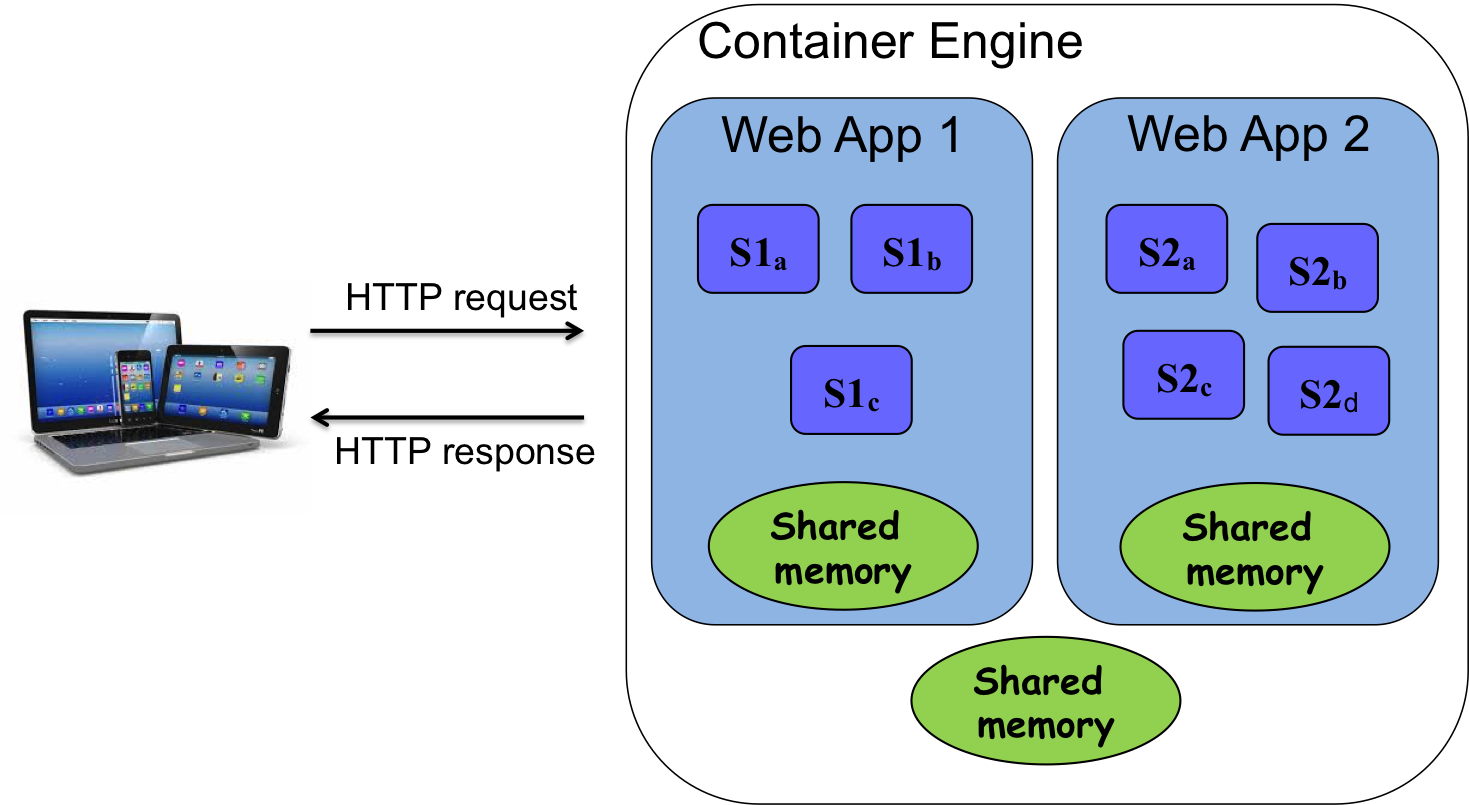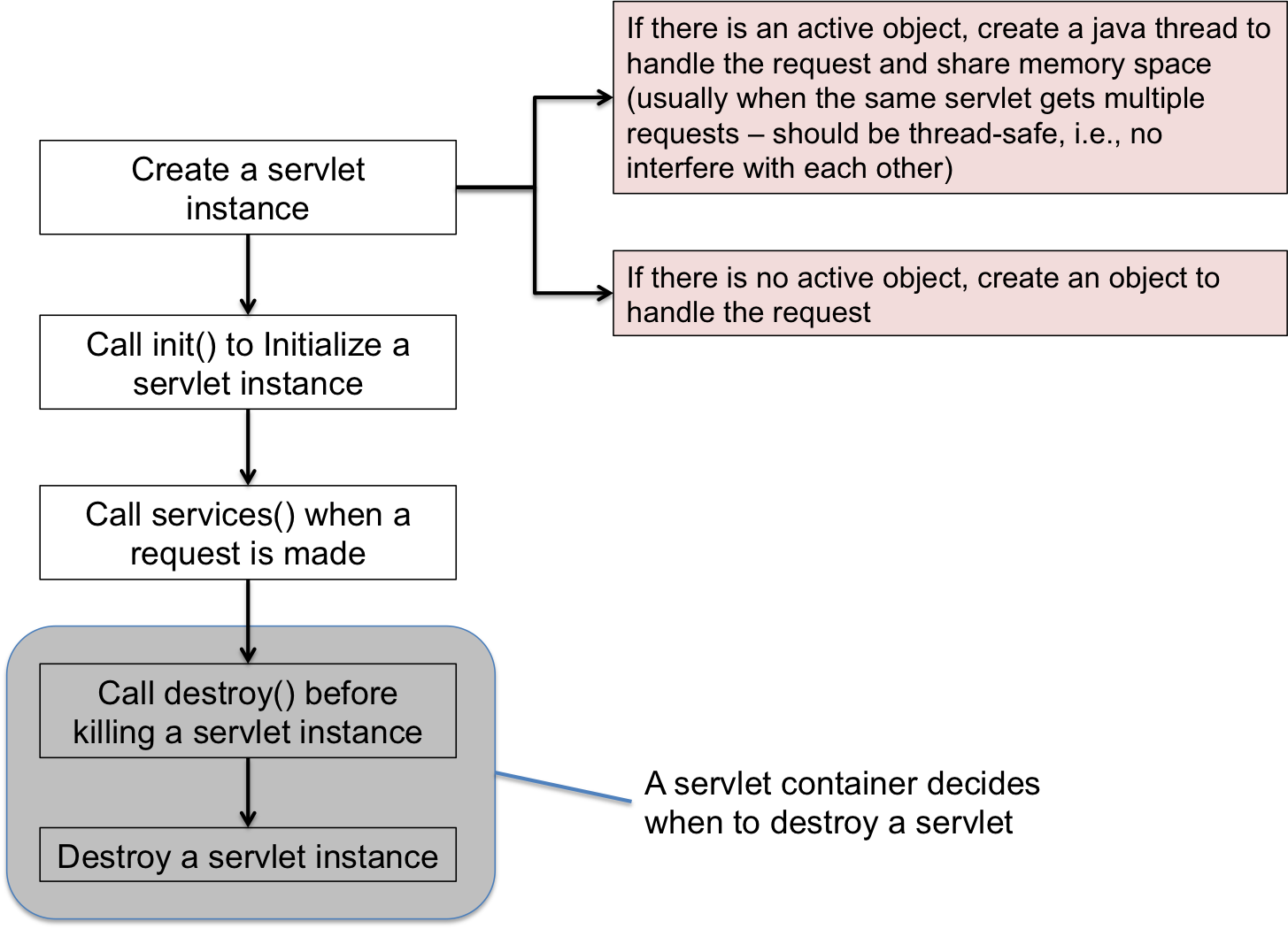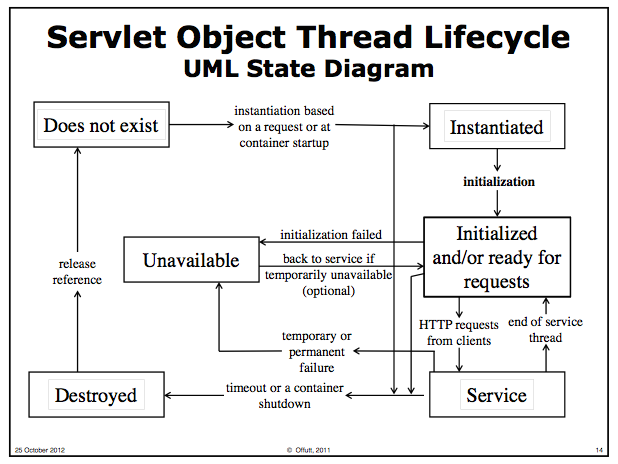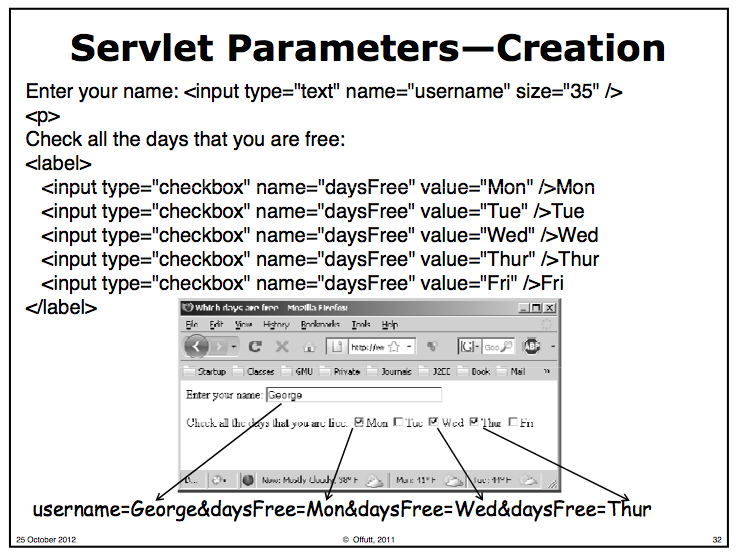Overview
What is a servlet?
- A Java object that responds to HTTP requests.
- Runs inside a servlet container (or sometimes called a servlet engine).

What does a servlet container do?

Servlet lifecycle

How to implement Java servlets?

Implement the interface
javax.servlet.Servlet
by extending either the class GenericServlet (javax.servlet.GenericServlet) or
HttpServlet (javax.servlet.http.HttpServlet).
Servlet methods
init()-- called when servlet starts to initialize servicesservice()-- called to process requests
- The entry point for the servlet (after init() is called)
- Called from the servlet container
- Decide what type of request is coming in and
then call the appropriate mehod
- HTTP GET requests --
doGet() - HTTP POST requests --
doPost()
- HTTP GET requests --
destroy()-- called by container before servlet process ends- To clean up the state of the servlet
- Informing another application the servlet is stopping
getServletConfig()-- servlet can access information about servlet container- Return a
ServletConfigobject (which stores information about the servlet's configuration)
- Return a
getServletInfo()-- servlet container can access information about servlet- Author
- Creation date
- Description
- Usage
- ...
Simple servlet example
import javax.servlet.*;
import javax.servlet.http.*;
import java.io.*;
public class Hello extends HttpServlet
{
public void doGet (HttpServletRequest req,
HttpServletResponse res)
throws servletException, IOException
{
res.setContentType (“text/html; charset=‘UTF-8’”);
PrintWriter out = res.getWriter ();
out.println (“<html>”);
out.println(" <head>");
out.println(" <title>Servlet example</title>");
out.println(" </head>");
out.println(" <body>");
out.rintln(" <p>My first servlet<g;/p>");
out.println(" </body>");
out.println("</html>");
out.close();
}
}
http://apps-swe432.vse.gmu.edu:8080/swe432/servlet/offutt.Hello
HttpServletRequest
- Represent the HTTP request a browser sends to a web application. Thus, anything the browser may send is accessible via the HttpServletRequest
- The request parameters are parameters
that are sent from the browser along with the request,
typically as part of the URL
or as part of the body of an HTTP request.
method call: System.out.println (“aString”); servlet parameters transmission: http://www example com/servlet/PrintThis?arg=aString multiple parameters are separated by '&' http://www.example.com/servlet/PrintThis?color=red&arg=Mike&age=39 order of parameters does not matter http://www.example.com/servlet/PrintThis?arg=Hello&color=red&age=39 empty string http://www.example.com/servlet/PrintThis?arg=&color=red&age=39 -
To access the parameters from the HttpServletRequest object
http://www.example.com/servlet/PrintThis?arg=Hello&color=red&age=39 protected void doGet( HttpServletRequest request, HttpServletResponse response) throws ServletException, IOException { String param1 = request.getParameter("arg"); String param2 = request.getParameter("color"); String param3 = request.getParameter("age"); }
- Most browsers give a warning before submitting POST data
for the second time -- to avoid duplicate submissions and updates
The page you are trying to view contains POSTDATA. If you resend the data, any action the form carried out (such as a saerch or online purchase) will be repeated. To resend the data, click OK. Otherwise, click Cancel.(how many users understand this message?)
HttpServletResponse
- Standard output is sent directly back to the client browser
- Represent the HTTP response a web application sends back to the browser, in response to the HTTP request the browser sends to the web application.
- To send response back to the browser
- The Content-Type header (i.e., a response header)
that tells the browser the type of the content
to be sending back must be specified.
- text/html -- send html back to the browser
- text/plain -- send plain text back to the browser
- A
PrintWriterfrom the HttpServletResponse object must be obtained and useprint()andprintln()to write HTML to browser
Example html from
name.html
<html> <head> <title>Name</title> </head> <body> <form method="post" action="http://cs.gmu.edu:8080/offutt/servlet/name"> Please enter your name: <input type="text" name="yourname" value="your name"> <br /> <input type="submit" value="Submit" name="submit"> <input type="reset" value="Reset" name="reset"> </form> </body> </html>Example servlet from name.java//Import Servlet Libraries import javax.servlet.*; import javax.servlet.http.*; //Import Java Libraries import java.io.*; import java.util.*; import java.lang.*; public class name extends HttpServlet { public void doPost (HttpServletRequest req, HttpServletResponse res) throws ServletException, IOException { res.setContentType ("text/html"); PrintWriter out = res.getWriter (); out.print ("<html>\n"); out.print (" <head>\n"); out.print (" <title>SWE 432: Name reading and printing</title>\n"); out.print (" </head>\n"); out.print (" <body>\n"); out.print (" <center><h2>Name reading and printing</h2></center>\n"); out.print (" <hr />\n"); String Nm = req.getParameter("yourname"); out.print (" Your name is: <font color=green>"); out.print (Nm); out.print (" </font>\n"); out.print (" </body>\n"); out.print ("</html>\n"); out.close (); } } - The Content-Type header (i.e., a response header)
that tells the browser the type of the content
to be sending back must be specified.
Redirecting to another URL from servlets
Servlets usually generate an HTML ile as a response, but sometimes you might want to send the client to a different servlet.
res.sendRedirect (“http://apps-swe432.vse.gmu.edu:8080/ ...”);
- The client will be sent to the specified URL
- Server tells the client to generate another request to the new URL
- Browser then repeats the request to the new URL
- Control is transfered to a new URL and does not come back
Writing to file from servlets
- File must be in a publicly writeable directory
/data/apps-swe43/swe432/WEB-INF/data/ - Open a file
FileWriter outfile = new FileWriter("/data/apps-swe432/swe432/WEB-INF/data/info-file.txt");
Open a file in append mode
FileWriter outfile = new FileWriter("/data/apps-swe432/swe432/WEB-INF/data/info-file.txt", true); - Write to a file
outfile.write( .... data to save .... ); - Close a file
outfile.close(); - Remember that we all share the same directory ... include your user name as part of the file name
HTTP requests
GET requests
- Generated when the URL is entered directly or
when
method="GET"is used in an HTML form doGet()is called fromservice()- The length of GET parameters is limited by some browsers (usually 1024 bytes)
- Put form data on the URL as parameters
http://www.example.com/servlet/PrintThis?arg=Hello&color=red&age=39 - Use GET when no data is sent (or just to receive data from server)
POST requests
- Generated when
method="POST"is used in an HTML form - The length can be arbitrarily
- Put form data in body of request
- Use POST when sending data to server
- To change state on server (update file or database)
- When there are a lot of data items
Deployment Testing
- Development and deployment computers often differ
- Web apps must be tested on final deployment platform
- Must test just as real users use it
- Issues to check for
- Different platforms (DOS / Unix / Linux / Mac ...)
- File names and path names (local/nonlocal, DOS/Unix)
- Upper case dependencies
- Incomplete deployment
- Compiler and runtime system version
- Permissions (data and DB)
- Different platforms (DOS / Unix / Linux / Mac ...)